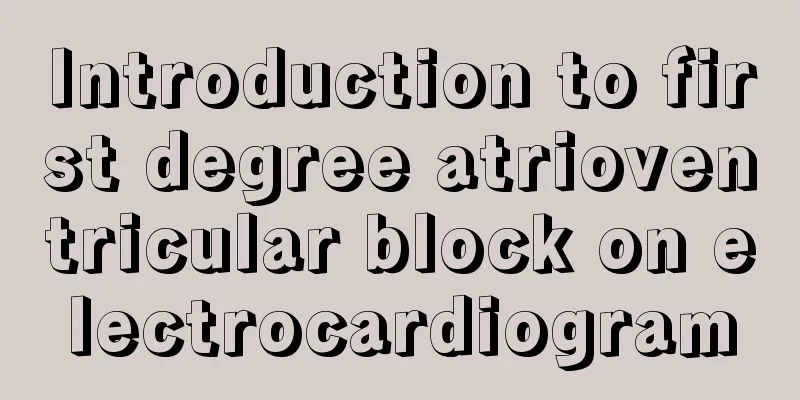Introduction to first degree atrioventricular block on electrocardiogram

|
First-degree atrioventricular block on the electrocardiogram actually means that the atrioventricular conduction time is prolonged, exceeding the normal range. It is good for us to have some understanding of this. This is a professional term in medicine and is also seen in the medical treatment of ordinary people. Therefore, it is always good to have some understanding of it and know it well. Now let’s understand what first-degree atrioventricular block is on the electrocardiogram. First-degree atrioventricular block can be seen in normal people, and some PR intervals can exceed 0.24s. The incidence rate in young and middle-aged people is 0.65% to 1.1%, and it can reach about 1.3% in normal people over 50 years old. It is caused by increased vagal tone, which occurs in up to 8.7% of some athletes. Certain drugs such as digitalis, quinidine, procainamide, potassium salts, beta-blockers and calcium antagonists, central and peripheral sympathetic nerve blockers such as methyldopa and clonidine can prolong the PR interval. Many scholars often call the PR interval prolongation caused by such factors atrioventricular conduction delay rather than atrioventricular conduction block. The prognosis is good. First-degree atrioventricular block is common in rheumatic myocarditis, acute or chronic ischemic heart disease. Its incidence in patients with acute myocardial infarction is 4% to 15%, especially in patients with acute inferior wall myocardial infarction. It is also seen in myocarditis, hyperthyroidism or adrenal insufficiency, congenital heart disease, heart surgery, etc. Most are temporary and disappear quickly or after a period of time. Primary conduction system fibrosis is a common cause in the elderly, presenting as long-term, progressive conduction block. The clinical manifestations are generally atrioventricular block induced by excessive vagal nerve tension, which is mostly first-degree or second-degree type I, second-degree type II rarely occurs, and does not produce high-degree or complete atrioventricular block. Therefore, second-degree type II, high-degree, and third-degree atrioventricular block are mostly caused by organic damage. The site of block in first-degree atrioventricular block is entirely within the His-Purkinje system. The His bundle electrogram confirmed that the block site was in the middle or lower segment of the His bundle in 35% of cases and in the upper segment of the His bundle in 65%. Chen Xin et al. (1997) pointed out that there were no reports of block sites in the atrioventricular node or atrium. On the surface electrocardiogram, about 29% of patients had narrow QRS waves (≤0.10s), and about 71% of patients had wide QRS waves (≥0.12s). The atrioventricular block induced by excessive vagal tone is mostly first-degree or second-degree type I, second-degree type II rarely occurs, and does not produce high-degree or complete atrioventricular block. Therefore, second-degree type II, high-degree, and third-degree atrioventricular block are mostly caused by organic damage. The site of block in first-degree atrioventricular block is entirely within the His-Purkinje system. The His bundle electrogram confirmed that the block site was in the middle or lower segment of the His bundle in 35% of cases and in the upper segment of the His bundle in 65%. Chen Xin et al. (1997) pointed out that there were no reports of block sites in the atrioventricular node or atrium. On the surface electrocardiogram, about 29% of patients had narrow QRS waves (≤0.10s), and about 71% of patients had wide QRS waves (≥0.12s). The atrioventricular block induced by excessive vagal tone is mostly first-degree or second-degree type I, second-degree type II rarely occurs, and does not produce high-degree or complete atrioventricular block. Therefore, second-degree type II, high-degree, and third-degree atrioventricular block are mostly caused by organic damage. The site of block in first-degree atrioventricular block is entirely within the His-Purkinje system. The His bundle electrogram confirmed that the block site was in the middle or lower segment of the His bundle in 35% of cases and in the upper segment of the His bundle in 65%. Chen Xin et al. (1997) pointed out that there were no reports of block sites in the atrioventricular node or atrium. On the surface electrocardiogram, about 29% of patients had narrow QRS waves (≤0.10s), and about 71% of patients had wide QRS waves (≥0.12s). The atrioventricular block induced by excessive vagal tone is mostly first-degree or second-degree type I, second-degree type II rarely occurs, and does not produce high-degree or complete atrioventricular block. Therefore, second-degree type II, high-degree, and third-degree atrioventricular block are mostly caused by organic damage. The site of block in first-degree atrioventricular block is entirely within the His-Purkinje system. The His bundle electrogram confirmed that the block site was in the middle or lower segment of the His bundle in 35% of cases and in the upper segment of the His bundle in 65%. Chen Xin et al. (1997) pointed out that there were no reports of block sites in the atrioventricular node or atrium. On the surface electrocardiogram, about 29% of patients had narrow QRS waves (≤0.10s), and about 71% of patients had wide QRS waves (≥0.12s). First-degree atrioventricular block usually does not produce hemodynamic changes. No special treatment is required for patients who are asymptomatic and do not have hypotension or sinus bradycardia. Treatment is mainly directed at the primary cause. For patients with a slow heart rate and obvious symptoms, oral atropine or aminophylline can be used. If adolescents experience prolonged PR interval but no obvious symptoms and the PR interval returns to normal after anti-rheumatic treatment, rheumatic fever should be considered. Asymptomatic patients with first-degree AV block within the His-Purkinje system must be closely followed because it may suddenly transform into second-degree type II AV block or even into high- or third-degree AV block. If the patient has a history of syncopal episodes and other causes have been ruled out. Although there is only first-degree atrioventricular block on the electrocardiogram, if the His bundle electrogram confirms first-degree block within or below the His bundle, pacemaker placement should still be considered. When the patient has a history of syncope and the PR interval on the electrocardiogram is normal, but the His bundle electrogram shows a significantly prolonged HV interval (>60ms), pacemaker placement should also be considered. Actively treating the primary disease, timely controlling it, and eliminating the causes and predisposing factors are the key to preventing this disease. Therefore, in our daily lives, we should develop standardized living habits, develop good work and rest time, a healthy attitude towards life, pay more attention to diet, and avoid overwork. If we can do some physical exercise every day, strengthen our body, improve immunity, keep a good mood, and live a positive and optimistic life, we can effectively avoid such diseases. |
<<: Couples can live longer if they do it six minutes before going to bed
>>: What is Cushing's syndrome
Recommend
What to do with pancreatitis and constipation
Pancreatic diseases are relatively common clinica...
Will breast cancer in situ recur?
Will breast cancer recur? Experts say that breast...
What to do if you have a chickenpox headache
Chickenpox is a highly contagious disease and als...
Why are eyes yellow in late stage liver cancer? Is it a complication?
Patients with advanced liver cancer will have com...
Black pepper essential oil
It is estimated that many people have not heard o...
What can patients with prostate cancer eat to relieve their condition
Suffering from prostate cancer is something that ...
Causes and treatments of back nerve pain
Sometimes muscle soreness may occur at a certain ...
4 causes of melanoma
Melanoma is one of the most common skin tumors. I...
What are the early symptoms of primary liver cancer? Five early symptoms of primary liver cancer
Suffering from diffuse primary liver cancer will ...
What are the surgeries for bladder cancer?
Bladder cancer surgery uses different surgical me...
What shampoo to use for dandruff
What shampoo should I use for dandruff? If a pers...
How much sleep is normal for an 8 month old baby?
Babies under one year old sleep more every day. T...
Teeth Whitening Mousse Side Effects
White teeth can greatly enhance your appearance, ...
What are the examination methods for rectal cancer
Rectal cancer is a disease that people often enco...
How to gain weight? Effective ways for thin people to gain weight
How to gain weight is a concern for many people w...









